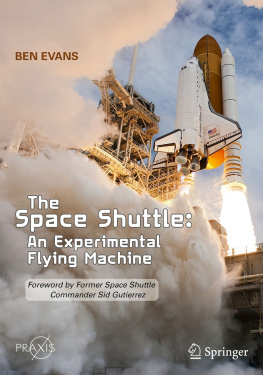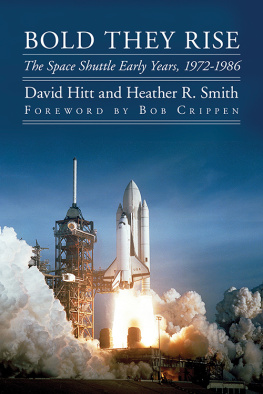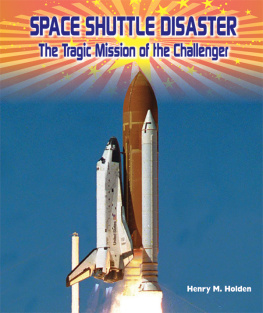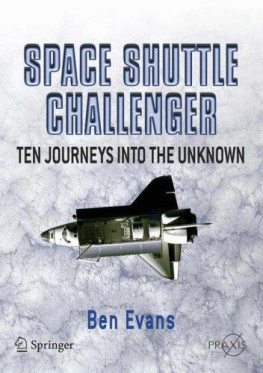Contents
Page List
Guide
Cover
NASA
SPACE SHUTTLE
40TH ANNIVERSARY

PIERS BIZONY
Essays by former NASA Chief Historian
Roger D. Launius

Contents
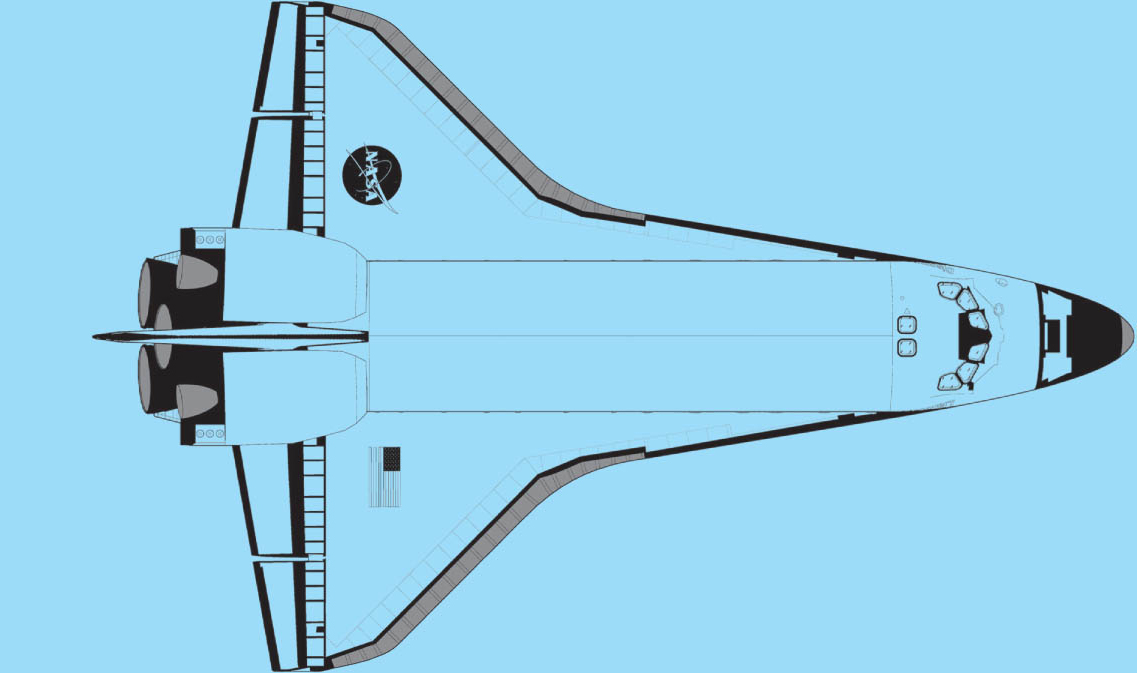

Introduction
NASAs famous Space Shuttle fleet retired in 2011, after thirty years of service. The four remaining orbiters, Atlantis, Endeavour, Discovery, and the prototype Enterprise, are now on display in museums. Our memories of the Shuttle program trigger mixed emotions. The first ascent to orbit by Columbia in April 1981 thrilled the world, but in January 1986, Challenger exploded 73 seconds after liftoff, within clear sight of thousands of spectators, and all seven crew members were killed. The story improved over the subsequent decade, with repairs to the Hubble Space Telescope conducted by Shuttle astronauts, and an impressive array of other mission successes. The Shuttle at its best was a highly adaptable workhorse of space, a perfect vehicle for people and payloads working in harness.
America thought of the Shuttle as a national emblem. Then, in February 2003, Columbia disintegrated during reentry, killing yet another crew of seven; and again, the Shuttles fortunes were revived, and the system ended its career on a dignified high note, after successfully completing the worlds largest and most complicated orbital habitat, the International Space Station.
The Space Shuttle was a science fiction dream come true, an awesome winged spaceship flying time and again into orbit and coming home to land like a plane. American expertise delivered a machine steered by humans allied with a complex array of computers, actuators, gyroscopes, and hydraulics, and powered by furious infernos of hydrogen, oxygen, aluminum powder, and ammonium perchlorate. It is extraordinary that such a vehicle ever could have been considered so well tamed that many of its launches seemed barely worth reporting by the media; and yet, this is what NASA mainly achieved. For the better part of three decades, and despite tragic setbacks, everyone took for granted the idea of American supremacy in space. This book is a reminder of the Shuttles greatest moments.
I am hugely grateful to Bert Ulrich, Multimedia Liaison at NASA Headquarters in Washington, D.C., and NASA Senior Photo Researcher Connie Moore. This book would not have been possible without their substantial and sustained assistance. Beyond the bounds of NASA, there are archivists whose boundless reserves of imagery and expertise alike always are invaluable. J. L. Pickering yielded some rare shots related to STS-1, the first orbital Shuttle mission. Ed Hengeveld was always on hand with ideas, and former NASA Public Affairs staffer Mike Gentry also was a constant source of help.
Fine-art photographers occasionally have gained special access to Shuttle launch operations, working dilligently through NASAs complicated security protocols and negotiating their way into good shooting positions. It takes tact and sensitivity to get great photos of NASA at work. Michael Soluri obtained extensive coverage of preparations for STS-125, the final Hubble Space Telescope servicing mission in 2009, and his images are luminous. A wide selection can be found in Michaels book, Infinite Worlds. Also, please note the image on . Michaels large-format photographs of hand-held tools used by STS-125s astronauts are in the permanent collection of the National Air & Space Museum in Washington, D.C.
Thanks also to Dan Winters, who set up his cameras at unprecedentedly close quarters to capture the last launches of Discovery, Endeavour, and Atlantis in fantastic detail for his book Last Launch, an invaluable historical and artistic record. In a similar vein, John Chakeres covered the dawn of the Shuttle era, and his book First Fleet was one of the first art volumes to cover this perpetually fascinating subject. I am grateful to John for providing some lovely shots. Of course, it is the astronauts themselves who took the greatest shots. We have so much else besides to thank them for.
Finally, the words in this book count just as much as the images. Many thanks to Roger Launius for his essays. As a former NASA chief historian, Roger is exceptionally well qualified to put the Shuttle story into perspective.
My taskindeed, my privilegehas been to assemble these elements and make them into a single project. The toughest part was deciding not so much what to include, but what to leave out. The Shuttle story is quite simply too amazing to be encompassed just in one volume, but here goes...

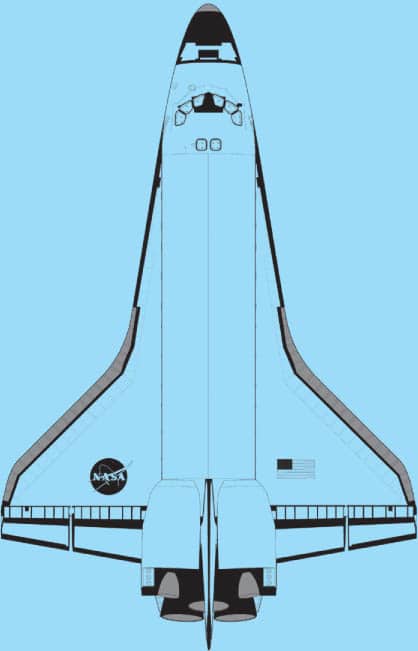
1 Building the Bird
From our descendants perches on other planets or distant space cities, they will look back at our achievement with wonder.
JOURNALIST WALTER CRONKITE OUR INFINITE JOURNEY, 2003
When the blast of a rocket launch slams you against the wall and all the rust is shaken off your body, you will hear the great shout of the universe and the joyful crying of people who have been changed by what theyve seen, enthused the great science fiction novelist Ray Bradbury in 1995. If anything, Bradbury, a writer seldom prone to understatement, played down the ferocity of a Space Shuttle launch. The experience was both electrifying and exhilarating. The sound vibrates the earth, said Bett Kelso, a Cocoa Beach resident who watched all of them. I stand in my front yard and I feel the staccatoits like a machine gun staccato, except much more powerful. Novelist Kurt Vonnegut likened it to a sexual experience. How would taxpayers feel if they found out they were buying orgasms for a few thousand freaks within a mile of the launch pad? And its a very satisfactory orgasm. I mean, you are shaking and you do take leave of your senses.

The Space Shuttle dominated human spaceflight for thirty years as the worlds first reusable rocket vehicle, lifting off 135 times over three decades, on a variety of impressive missions. In the process, this spacecraft turned Earth orbit into a normal realm for human activity. Americas first astronautsespecially during the Mercury, Gemini, and Apollo programswere pioneers, explorers in the truest sense of the term. But frontiers do not remain frontiers forever, as more people reach them, engage in useful activities, and occupy and use them. This happened in the American West and it also is taking place now in orbit. And the Shuttle was the vehicle that made this possible.


